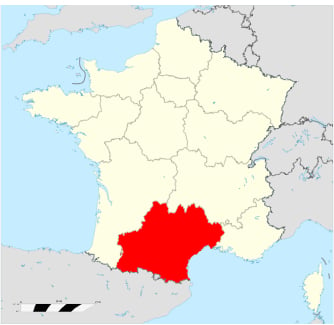France is well and truly spoiled when it comes to beautiful cities, so much so that many villes that aren’t that glamorous often get completely overlooked.
But bland can be beautiful in the land of Molière, and a recent survey that looked at the best places to live, points to just that.
In 2018, the French weekly news magazine L’Express ranked French towns and cities (except Paris) according to factors such as hours of sunshine, cultural offerings, air quality, student population, access to healthcare, safety, proximity to the sea or mountains and property prices to work out just where the best places to live were.
As of 2024, the team at The Local still found these recommendations to hold weight.
Their findings may have you coughing up your pain au chocolat, or at least rethinking where you’d like to move to. While Rennes in western France topped the ranking we have focussed on the the next six cities in the ranking.
Limoges
Limoges, listed as a Ville d’Art et d’Histoire, it’s the birthplace of French painter Renoir. It’s located in central western France just off the motorway that links Paris to Toulouse in the south west.
Travel guides on France might skim over Limoges as a place to visit, but that may be to its residents’ benefit.
The once porcelain capital of France is now a bustling student city of 139,000 in the central department of Haute-Vienne, and L’Express noted that it ranked highly on its quality of life survey.
Angers
Despite its moody sounding name to English speakers, by most accounts Angers is a bustling, happy-go-lucky city with loads to offer.
Steeped in history from its days as an intellectual hub in the 15th century, the city has a rich cultural offering of museums, festivals, art galleries and medieval chateaux. It also serves as the gateway to the splendid Loire Valley, famed for its gastronomy and natural beauty.
The Lonely Planet has praised Angers’ ‘cafe culture’, noting the 42,000 students that call the city home. It’s also just over one hour and a half by train from Paris or three and a half hours’ drive.
L’Express ranked it as the third place to live in France in 2018. That clearly has not changed, as it ranked in first place in the 2024 edition of the ranking of towns and villages in France ‘where life is good’, published by the Journal du Dimanche.
Clermont-Ferrand
Back in April 2016, The Local ran a feature that laid out 15 reasons why Clermont-Ferrand is the best place in France. It was written by a proud former resident who was sick an tired of the ciy being overlooked an it caught the attention of many Clermontois who modestly admitted their city was great but not the best.
Surrounded by ancient volcanoes, Clermont-Ferrand has a majestic twin-turreted cathedral, loads of fountains and squares as well as 18th-century mansions made out of volcanic stone. It’s also ideal for nature lovers with the Parc Naturel Régional des Volcans d’Auvergne a short drive away.
As Lonely Planet puts it, “Clermont-Ferrand is a hub not only for business but cuisine, with plenty of restaurants serving modernised cuisine auvergnate, and culture (in the form of fizzing art, film and live-music scenes).”
L’Express ranked it in fourth place, and more recently in 2023, the real estate platform Maslow put it in first place for ‘the best places to invest in (existing) property’.
Brest
Brest won’t win any beauty contests, that’s for sure. It was quickly rebuilt in a rather functional manner after being almost fully obliterated by bombs during WWII, but that did not stop this port city in Brittany from taking fifth place according to L’Express.
So what’s there to love? Well if it’s sea you’re after, this coastal city on the West Atlantic is known for its amazing aquarium and sailing competitions, although the waves can get fairly choppy.
What’s great about Brest is what’s surrounding it – there are several islands, such as the Île d’Ouessant, that you can visit directly from the city. Enjoy hiking, or just take in the gorgeous sights from cliffs to sandy beaches.
Lonely planet has called Brest “big, bold and dynamic” but maybe it’s the unassuming attitude of the city’s 139,619 inhabitants that make it the perfect place to live for them.
Saint-Etienne
It is easy to spend a few days in Lyon without considering a trip to Saint-Etienne, which often goes unnoticed.
Formerly known as France’s main armaments manufacturer, this industrial city has smartened up its centre and suburbs over recent decades and is reinventing itself as a design city, including an impressive museum of modern art.
And its old town, as with many towns and cities in France, still has plenty of charm. It’s split by two rivers – Le Rhône and La Saône – and made up of narrow streets, decorative buildings and quirky shops.
Lorient
Another city in Brittany that made it into the top ten most livable spots in L’Hexagone (maybe it’s something to do with living by the seaside?).
In Lorient’s case though, it’s possibly a more obvious choice than for its Breton brother of Brest. This small city has lovely white sand beaches with waves big enough to draw in surfers, a fantastic bay to stroll around, picturesque countryside just outside town and a well-preserved old town.
You can also take an easy ferry ride to the Île de Groix from Lorient.
In August, Lorient plays host to a huge Celtic festival, which draws in thousands of Celtic communities from around Europe.
Would you live in any of these places? Let us know in the comments below.




 Please whitelist us to continue reading.
Please whitelist us to continue reading.
Yes. We live about an hour from Limoges. Lovely area to live. Quiet and clean. Limoges has its areas of high crime (ask locally), and these are well-known, but mainly it’s a handsome city with fine architecture, good facilities and pleasant people.
Boulogne sur Mer – my home town and fishing capital of France and 30 minutes from Car Shuttle and Calais Ferries should also be on your list IMO
I love Sommières, in Gard Dept. It’s peaceful & beautiful. And it has a lot going for it. But it does not have a train station. (Apparently, that was decommissioned years ago, the station building now serving as a lovely hotel.) Sommières is a slice of heaven and Nîmes and Alès are not far away.